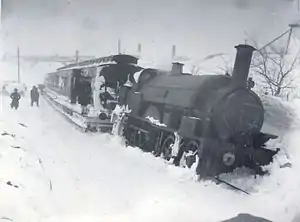South Devon Railway Leopard class
The Leopard class were four 4-4-0 saddle tank broad gauge designed for passenger trains but were also used on goods trains when required. They were built by the Avonside Engine Company for the South Devon Railway, but also operated on its associated railways. Although designed for easy conversion to standard gauge this was never carried out.
| Leopard | |||||||||||||||||||
|---|---|---|---|---|---|---|---|---|---|---|---|---|---|---|---|---|---|---|---|
 Leopard derailed in snow near Camborne, 8 March 1891 | |||||||||||||||||||
| |||||||||||||||||||
| |||||||||||||||||||
| |||||||||||||||||||
On 1 February 1876 the South Devon Railway was amalgamated with the Great Western Railway, the locomotives were given numbers by their new owners but continued to carry their names too.
Locomotives
- Lance (1875 – 1892) GWR no. 2130
- It was one of two locomotives kept working at Swindon railway works for shunting the broad gauge stock into the workshops for conversion or dismantling, until it too was dismantled in June 1893.
- This was the second South Devon Railway locomotive to carry this name, it was previously carried by a Comet class locomotive. The name is that of a thrown weapon, a lance.
- Leopard (1872 – 1893) GWR no. 2128
- It was one of two locomotives kept working at Swindon railway works for shunting the broad gauge stock into the workshops for conversion or dismantling, until it too was dismantled in June 1893.
- This locomotive is named after the leopard, a fast animal.
- On 8 March 1891, Leopard was derailed in a blizzard near Camborne, Cornwall whilst working a relief passenger train.[1]
- Osiris (1875 – 1892) GWR no. 2131
- This was the second South Devon Railway locomotive to carry this name, it was previously carried by a Comet class locomotive. The name is that of an Egyptian god, Osiris.
- Stag (1872 – 1893) GWR no. 2129
- This locomotive is believed to have worked the last train on the St Ives branch on 20 May 1892 before this and all other lines were converted to standard gauge. It then took the empty coaches from there to Swindon railway works where it was kept for shunting the broad gauge stock into the workshops for conversion or dismantling, until it too was dismantled in June 1893.
- A stag is a fast animal.
References
- Earnshaw, Alan (1990). Trains in Trouble: Vol. 6. Penryn: Atlantic Books. p. 4. ISBN 0-906899-37-0.
- Sources
- Reed, P.J.T. (February 1953). White, D.E. (ed.). The Locomotives of the Great Western Railway, Part 2: Broad Gauge. Kenilworth: The Railway Correspondence and Travel Society. ISBN 0-901115-32-0. OCLC 650490992.CS1 maint: ref=harv (link)
- Beck, Keith; Copsey, John (1990). The Great Western in South Devon. Didcot: Wild Swan Publications. ISBN 0-906867-90-8.CS1 maint: ref=harv (link)
- Gregory, R H (1982). The South Devon Railway. Salisbury: The Oakwood Press. ISBN 0-85361-286-2.
- Waters, Laurence (1999). The Great Western Broad Gauge. Hersham: Ian Allan Publishing. ISBN 0-7110-2634-3.
- Railway company records at The National Archives
This article is issued from Wikipedia. The text is licensed under Creative Commons - Attribution - Sharealike. Additional terms may apply for the media files.